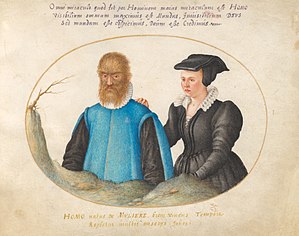Hypertrichosis
| Hypertrichosis | |
|---|---|
 |
|
| Petrus Gonsalvus, "The Hairy Man" by Joris Hoefnagel from his "Elementa Depicta." | |
| Classification and external resources | |
| Specialty | Dermatology |
| ICD-10 | L68, Q84.2 |
| ICD-9-CM | 704.1, 757.4 |
| OMIM | 135400 |
| DiseasesDB | 20886 |
| MedlinePlus | 003148 |
| eMedicine | article/1072031 |
| MeSH | D006983 |
Hypertrichosis (also called Ambras syndrome) is an abnormal amount of hair growth over the body; extensive cases of hypertrichosis have informally been called werewolf syndrome, because the appearance is similar to the mythical werewolf. The two distinct types of hypertrichosis are generalized hypertrichosis, which occurs over the entire body, and localized hypertrichosis, which is restricted to a certain area. Hypertrichosis can be either congenital (present at birth) or acquired later in life. The excess growth of hair occurs in areas of the skin with the exception of androgen-dependent hair of the pubic area, face, and axillary regions.
Several circus sideshow performers in the 19th and early 20th centuries, such as Julia Pastrana, had hypertrichosis. Many of them worked as freaks and were promoted as having distinct human and animal traits.
Two methods of classification are used for hypertrichosis. One divides them into either generalized versus localized hypertrichosis, while the other divides them into congenital versus acquired.
Congenital forms of hypertrichosis are caused by genetic mutations, and are extremely rare, unlike acquired forms. Congenital hypertrichosis is always present at birth.
Congenital hypertrichosis lanuginosa is noticeable at birth, with the infant completely covered in thin lanugo hair. In normal circumstances, lanugo hair is shed before birth and replaced by vellus hair; however, in a person with congenital hypertrichosis lanuginosa, the lanugo hair remains after birth. The palms of the hands, soles of the feet, and mucous membranes are not affected. As the person ages, the lanugo hair may thin, leaving only limited areas of hypertrichosis.
Congenital generalized hypertrichosis causes males to exhibit excessive facial and upper body hair, whereas women exhibit less severe asymmetrical hair distribution. The palms, soles, and mucous membranes are not affected.
Congenital terminal hypertrichosis is characterized by the presence of fully pigmented terminal hair that covers the entire body. This condition is usually accompanied by gingival hyperplasia. This form is most responsible for the term "werewolf syndrome" because of the thick, dark hair that appears. People with this condition are sometimes performers at circuses because of their unusual appearance.
...
Wikipedia
